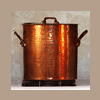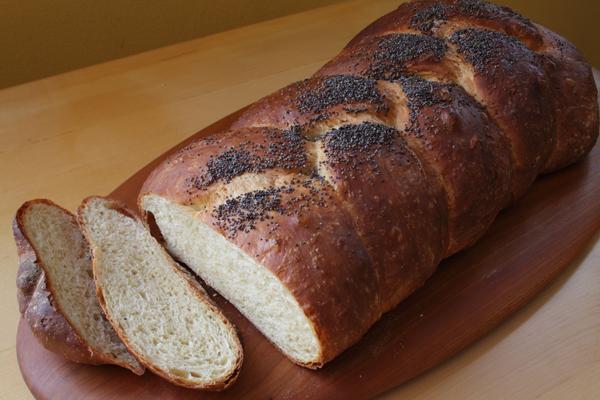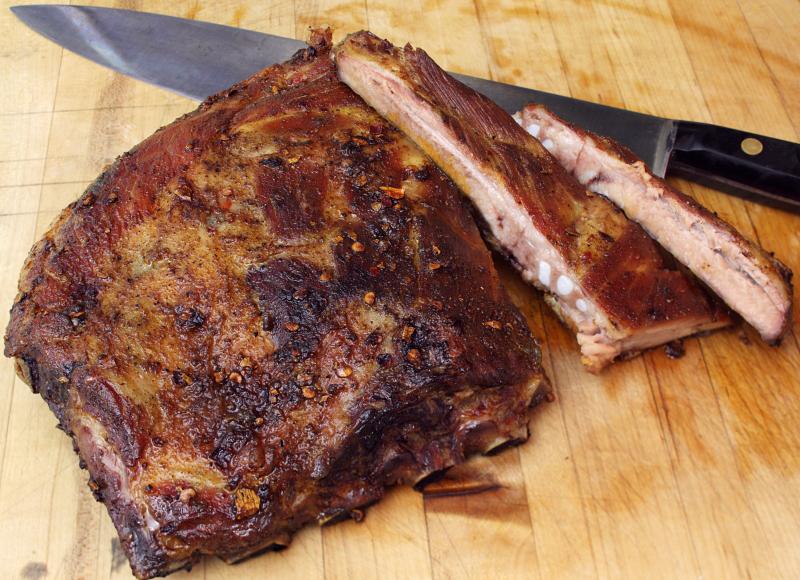-
Posts
1,307 -
Joined
-
Last visited
Content Type
Profiles
Forums
Store
Help Articles
Everything posted by David A. Goldfarb
-
I just made chicken adobo (Philippine style) for a charity auction for my son's preschool where those of us who were providing main dishes were asked to cook for about 60 people. I noticed that this was going to be one of about four mains, so I cooked for about 25-30 (six chickens plus around 30 cups of rice on the side). The quantity wasn't too difficult, but it turned out that everyone who was cooking made too much food and there were only about 35 guests, so not much of a dent was made in the adobo or any of the main dishes for that matter. I'd happily make adobo for 30 or 60 people again, but I think next time, I might inquire in more detail to be sure there will be people there to eat it. Rosehip preserves are something that seemed like a lot of work for not much return. I think I'd need a very large quantity of rosehips to feel like I had a batch big enough to deal with that again.
-
You might find yourself shopping around for different things in different places. Mediterranean items might show up at O & Co. in Grand Central Terminal (one of the only places in NYC that carries AOC Piment d'Espelette, for instance) or Sur La Table in SoHo, for instance. There are fairly good spices available at Zabar's and Fairway and also Sahadi's on Atlantic Avenue in Brooklyn. Then there are internet suppliers like Zingerman's, L'Epicerie, TerraSpice, and Chefshop.
-

What's the Oldest Thing in Your Kitchen?
David A. Goldfarb replied to a topic in Food Traditions & Culture
The last apartment we lived in in Manhattan had a box like that, but it was on the sixth floor of an apartment building, so it was definitely not for milk delivered from the outside. I don't know if it was a cold box or maybe a box for storing fuel for a coal or wood fired stove before gas was installed. There was a metal plate on the wall for a flue near the stove. The apartment also had a defunct dumbwaiter. My grandmother had a milk box in her house in the Eastside suburbs of Cleveland, and there was a flat door with a latch that could be opened on the inside and an identical door on the outside. -
I might flavor the oil for stir frying with garlic and ginger and maybe some dried chili pepper, then remove the whole spices so they don't burn in the wok while the food is cooking.
-
I don't usually peel it if I'm grating it, but otherwise I tend to. If the ginger is really fresh, the skin will be moist and won't require peeling. I've only found it like this in Asian markets.
-

Does taking food photos bother customers or staff?
David A. Goldfarb replied to a topic in Restaurant Life
I photograph food quite a bit, not usually in restaurants where I'm just eating a meal, but if I do, I try to use a fast lens and high enough ISO setting on my camera to do it without flash, and I just try to take advantage of whatever lighting happens to be available in the restaurant. Direct flash isn't usually very flattering to food or people or many other things for that matter, and I think it would be a bit obtrusive to do much more than direct flash in a restaurant situation. If I think I might make photographs, I'll try to get a seat near a window when there's daylight, but if not, I just pay attention to the direction of the light and make do with what's there, and I use whatever I can to brace the camera, so I can use a slow shutter speed. Here's a plate of Romy's Spareribs from the last night at Cendrillon on Mercer St. in Manhattan before they closed-- It was pretty dark, and the lens was a 35mm/f:2. I probably had my arms braced on the back of a chair (it was a party, so walking around was appropriate) or a table to hold the camera steady. I shot in RAW so that I could easily adjust the color balance afterward without losing quality. Auto White Balance is often not terribly reliable, and in a restaurant, you may have mixed lighting sources, so this can be a bit tricky. -
We eat lots of brown rice. We'll go through a 20 pound bag of Nishiki medium grain brown rice without it going rancid. We also like the Lundberg long grain brown, short grain brown (a little stickier), and brown basmati rices, and sometimes we make black or red rice. The only white rices we eat are arborio or carnaroli for risotto, white basmati once in a while, sometimes short grain sticky white rice for sushi, and occasionally I might get a Spanish style white rice for dishes where that would be appropriate. Most common white rice is boring and flavorless (there are exceptions, of course). We usually make it in a rice cooker that has two settings--on and warm.
-
Sounds great!
-
Here's today's batch, made with the KitchenAid mixer. This time with King Arthur First Clear Flour and four yolks instead of two whole eggs (because I used the whites to clarify stock).
-
But is it a temperature related phenomenon that one is waiting for when resting meat? I suppose in some sense it is, but usually the reason that one rests the meat is so the juices don't all leak out right away, and there is no reason to believe that 5F from peak is a good rule of thumb for that, since it would imply that a rare steak won't leak at 115F (if you consider 120F rare for a steak) and a well done steak won't leak at, say 130F (if you think of 135F as well done). I would sooner believe a theory that a steak should be served at 115F, no matter what the peak temperature was, but I'm not sure if that's the case either. And then there's the HACCP guideline that hot food should be held at 135F or higher, which we're probably all ignoring at home.
-

Meals that require at least an hour in the oven unattended
David A. Goldfarb replied to a topic in Cooking
Do you have a rice cooker, and do you like rice? If you do, then any kind of braised dish or stew can be served with rice, and you can set it up an hour in advance, and it will be ready when you're ready to eat. The rice won't necessarily take an hour, but I like it to sit a bit after it's done cooking. In my opinion, a fancy rice cooker is unnecessary, unless you plan to use it for things other than rice. Commercial rice cookers only have two settings at most--on and warm or on and off (since there are also commercial rice warmers that do nothing but keep rice warm). -

Restoring & Updating a Vintage 1950s Kitchen
David A. Goldfarb replied to a topic in Kitchen Consumer
Here you go. This is life in your new "modern" home-- http://www.mefeedia.com/watch/29779302 -
Usually about 10 minutes for most things that I make most of the time--steaks, a roast chicken or duck, a small roast. Up to 20 minutes for something like a standing rib with 4 or more ribs or a turkey. More like 5 minutes for small things like tournedos or a chicken or veal paillard.
-
It's an asparagus peeler. If you google "asparagus peeler" or perhaps "Spargelschäler," you'll find a surprising variety of implements for this purpose.
-
This has got to be the best unitasker-- http://www.testberichte.de/p/lurch-tests/spargelschaeler-testbericht.html Be sure to watch the video.
-
I don't typically seed tomatoes, and I only peel if I'm using them in a sauce or soup and don't want little slips of peel in it. If it's just a few tomatoes, I'll peel them with a very sharp knife. If it's more than about five or six tomatoes, I'll blanch and peel.
-
Here's an example (nicer than mine) of a zester-canelleur-- http://www.la-carpe.com/outils-de-cuisine/699-zesteur-canelleur-rosle-en-inox.html The canelleur ("channeler") is the loop on the side, and you can use it for cutting nice curls of citrus peel without too much pith, or for cutting channels down the length of a carrot as a garnish, or for cutting a band around the skin of new potatoes for steaming or boiling so they can expand without cracking. In the kit that contains my zester-canelleur there's also a tomato stem scooper, which I think must be the ultimate unitasker. It also has a butter curler. These things were all part of a Messermeister garde manger set that my father gave me once for my birthday, figuring that there were probably a few things in there that I didn't already have, and there were.
-
Lamb fat can be easily overpowering, so I can see why it isn't commonly used as lard, though I'd imagine that somewhere in the world where sheep are the dominant protein it may be. People who don't like lamb are usually reacting to lamb cooked with too much fat.
-
I have a sturdy Teutonic metal egg slicer, because it's a beautiful thing, and my three-year-old son is more likely to eat hard boiled eggs more often if it means he gets to use the egg slicer. Interestingly, he prefers the whites and leaves most of the yolk on his plate--certainly a healthy preference, even if it runs contrary to the opinion of everyone else on the planet. I have a duotasking pitter, good for cherries and large olives, but for small olives, I have a unitasker. Alton Brown is welcome to poke himself in the hand with a skewer or whatever he uses to pit olives without one. My zester also has a canelleur as they often do. Isn't that an efficient multitasking tool? I don't often use a garlic press, but I have one, and it can also press disks of fresh ginger.
-
Sometimes I'll use bacon as the fat for things like sauteed greens or vegetables or for pasta dishes--just diced bacon, rendered and left in the dish for another texture. I've used rendered bacon fat in fruit pie crusts, like cherry or apple, and it is really good.
-
For roasted root vegetables, I like to saute a bit in duck fat in a cast iron pan and then put the pan in oven to roast. Chicken fat for the best caramelized onions. I keep a deep fry pot in the fridge filled with beef fat (maybe with some bacon drippings thrown in) for French fries and other deep fried things. For stir fry I usually use peanut oil.
-
So today I decided to make a challah using the recipe I posted above (post #8), and I was short of bread flour, so I tried it with King Arthur First Clear flour, and I had an extra egg yolk, so I added it, keeping the total volume of water and egg the same--big improvement in flavor, and I really liked the texture. It took a couple of tablespoons more First Clear than bread flour to hold together, so maybe figure 3-3/8 or 3-3/4 cups first clear. First clear flour in general is used together with rye flour in Jewish rye bread, so it wouldn't be surprising if there were some tradition of using first clear in challah. It's less refined than white flour, so maybe poor people used it, which would probably mean that it tasted better. There's a good description of what first clear flour is here-- http://www.thefreshloaf.com/node/6194/first-clear-flour
-
I also like hemostats for bones that are more substantial than what you can get with fish tweezers (I have a few of the latter that I bought in a Chinese market for about a dollar a piece). I suppose that for very large fish with bones too heavy for a hemostat, pliers may be in order.
-
Not too bad for indoor smoking, I'd say. I did these with just a rub, no sauce. The smoke flavor was fairly light, and I think a little more would be good, so I'd be tempted to let it go 2 or 2-1/2 hours next time in the wok with damp wood chips instead of 90 minutes as I did this time, before transferring it to the oven. While it's not the same as fully smoked ribs, it's a new flavor in my kitchen, different from Liquid Smoke, and different from the other indoor methods I've used for making ribs. I can see a lot of experimenting happening with this this summer.



